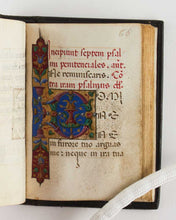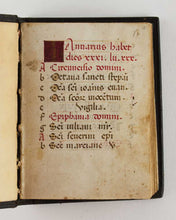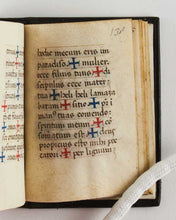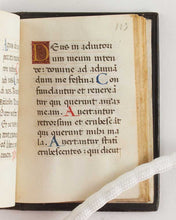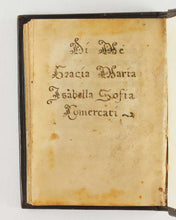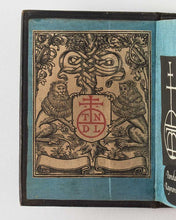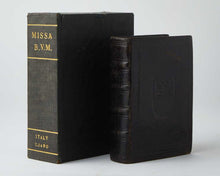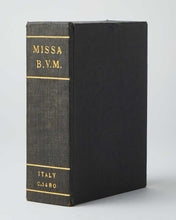
[ILLUMINATED MANUSCRIPT.] Prayerbook in Latin and Italian. [Bologna. c. 1490-1500.]
Manuscript on vellum, 95 x 70 mm. 19th-century dark brown morocco, blind armorial supralibros within rope border to centre of covers, blue silk doublures, housed in a modern custom-made black cloth box; ff. ii, 144, ii: 1-28, 3-810 (f. 31 in 4, apparently in original condition on a stub and with outer edge made-up), 98, 10-1510, complete, catchwords in lower margins of final versos, guide letters visible, foliation in black ink in upper corners from second to final flyleaves 1-146 (two leaves numbered “98” as also “136”) followed here, 11 lines neatly written in black ink in a round gothic bookhand between two verticals and twelve horizontals ruled in brown, justification: 60 x 45 mm, rubrics in red, text capitals touched yellow, one-line initials in alternate blue and red, two-line initials of liquid gold on grounds of green, red or blue with scrolling decoration, large illuminated 7-line initial “S” (f. 31v) enclosing Virgin and Child, initial entwined by elaborate foliage, painted in green and blue, heightened in gold, and set against a magenta ground, with accompanying panel border including jewels and pearls, and large 5-line historiated initial “D” (f. 86) painted magenta and green including jewels and pearls, against blue and gold ground, with matching full-page partial border; extremities of binding very lightly rubbed; a little smudging to page with historiated initial, occasional small stain, but generally very well preserved; title to second front flyleaf and ownership inscription to lifted rear pastedown in a single 19th-century hand in black ink, modern bookplates to front flyleaf and inside upper cover (see below).
An elegant manuscript prayerbook on vellum, produced in Bologna in the 1490s, apparently the result of collaboration between the calligrapher Pierantonio Sallando and an illuminator from the circle of the great painter and jeweller Francesco Marmitta.
Illumination:
The Mass of the Virgin (“Missa Beatae Mariae Virginis”, f. 31v) opens with a large illuminated initial “S”, depicting a half-length Virgin adoring the Christ Child, and an elaborate full-page border. The colour palette (dark red, blue, green, black and gold) and the use of attenuated architectural forms, jewels and foliage place this manuscript alongside a group of Books of Hours produced for aristocratic patrons in Bologna around 1500 (cf. Medica). Many of these manuscripts resulted from the partnership between illuminators in Bologna – the most influential among them Francesco Marmitta (c. 1460-1505) – and the prolific calligrapher Pierantonio Sallando (c. 1460-1540). Together Marmitta and Sallando developed the sophisticated architectural borders, such as those of the present prayerbook, that became a hallmark of Bologna’s finest High Renaissance manuscripts. Their most celebrated and luxurious joint effort is the Offiziolo Durazzo (Genoa, Bib. Civ. Berio, m.r.cf.Arm.I).
Our prayerbook was apparently also written by Sallando. The illumination may be ascribed to the same painter who collaborated with Marmitta on the Rangoni-Bentivoglio Hours (Baltimore, WAG, ms W.469) and contributed to other Hours written by Sallando in Oxford (Bodleian Library, ms Canon. Liturg. 260), Bassano del Grappa (Bib. Civ., Esp. 4 ms 1564), and the Hours of Giovanni II Bentivoglio (NY, Morgan Lib. Ms M.53). In the present manuscript, the two large initials and borders on f. 31v and f. 86 share similar forms and colour palette. Stylistically closely related borders are found in one of Sallando’s most famous commissions, the Hours of Bonaparte Ghisilieri illuminated by Amico Aspertini, Perugino and Matteo da Milano (BL, Yates Thompson 29).
Contents:
Calendar (ff. 2-19v); Confessio generalis (ff. 20-21); Gospel Extracts (ff. 21-31); Missa Beatae Mariae Virginis (ff. 31v-49); Prayer of St Augustine opening “Deus propicius esto mihi peccatori” (ff. 49v-51v); Fifteen prayers on the Passion as said daily by St Bridget and indulgenced by Boniface VIII, opening “O domine iesu christe eterna dulcedo” (ff. 51v-80); Apostles Creed (ff. 80-81); Sequence of prayers (ff. 81v-85), to be said daily while kneeling before an image of Christ to keep from the pain of Hell, to gain divine assistance, counsel and favour, and when body or soul are in danger; Seven Penitential Psalms and Litany (ff. 86-116v); Prayers and devotions addressed to God, opening with Psalm 68 and including two prayers naming the owner, “famulo tuo Jacobo” (ff. 125v, 126v, and 133), and ending with a prayer to protect when travelling and a prayer to the Guardian Angel (ff. 117-134); Prayers attributed to St Bernard and other indulgenced prayers (ff. 135-143v).
Provenance:
1. The Calendar includes the feast of St Petronius, the patron saint of Bologna, in red indicating that the manuscript was made in or for use in that city. It was written for a man who is named as “Jacobus” in prayers on ff. 125v, 126v and 133. His coat of arms was presumably painted on f. 31v but has been overpainted with a golden bird on a blue background and the initials “N. M.” (arms unidentified).
2. Nineteenth-century manuscript title “Missa Beatae Virg. & aliae Orationes” on the second front flyleaf and ownership inscription, “Di Me Gracia Maria Isabella Sofia Comercati”, on the lifted rear pastedown, likely contemporary with the present armorial binding (arms unidentified).
3. Michael Tomkinson of Franche Hall, near Kidderminster (1841-1921), collector of books and Japanese art: his bookplate to front flyleaf, and a related stamp on a bookplate inside upper cover (not traced in his sales, Sotheby’s, April and July 1922).
4. Pamela and Raymond Lister: their bookplate to front flyleaf; sold Sotheby’s, 10 July 1967, lot 68, to Maggs.
5. Christie’s London, “Valuable Manuscripts and Printed Books”, 4 June 2008, lot 55.
See Medica, “La miniatura a Bologna al tempo di Giovanni II Bentivoglio”, in Il Libro d’Ore di Bonaparte Ghislieri, 2008, pp. 44-104.
#2123427












